At the end of each year, many people comment on how fast the year went by: “where did the time go?” So a sluggish start has much to recommend it. Early one cool and damp morning, two African banana slugs in a large fern outside the bedroom window showed me the way.
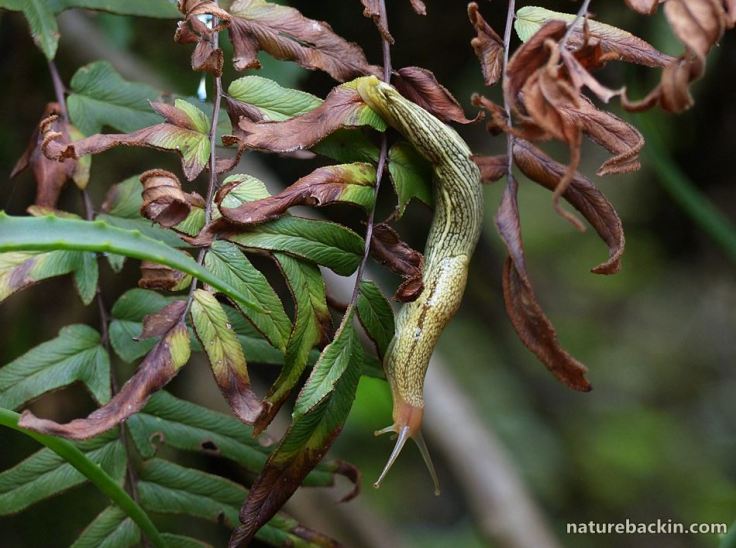
Slugs can be surprisingly agile, albeit in a rather – um – sluggish kind of a way
African banana slugs (Elisolimax flavescens) can be variable in colour, even within the same region. I usually see the yellow ones, and perhaps I only noticed the paler one in the above photo because it was accompanied by a bright yellow one in the same fern.

The yellow slug was intent on eating a leaf from a fern that was large enough to provide the slug with breakfast without any noticeable damage
The African banana slug is a herbivore, as are most slugs. Many also eat decaying plant material and fungi. Some slugs are carnivores, eating other molluscs and carrion. Only a minority of slug species cause damage to agricultural crops.
I always thought that the African banana slug (as the North American banana slug from an entirely different family) was so called because many of them are yellow in colour (like a banana). Only when reading for this post did I learn that the African banana slug can be a pest to banana growers, as it feeds on the skins of ripening bananas. In addition to banana plantations, African banana slugs can be found in a variety of habitats, including forest, grassland, savanna and thicket and it occurs in the eastern regions of southern Africa.
Slugs have an interesting anatomy and physiology. Their main organs are in the front part of the body under the thicker mantle below the head. They breathe through a breathing pore on the right side of the body that feeds oxygen to one lung. The mucus that slugs exude assists in this process of absorbing oxygen and also helps keep the shell-less body hydrated.
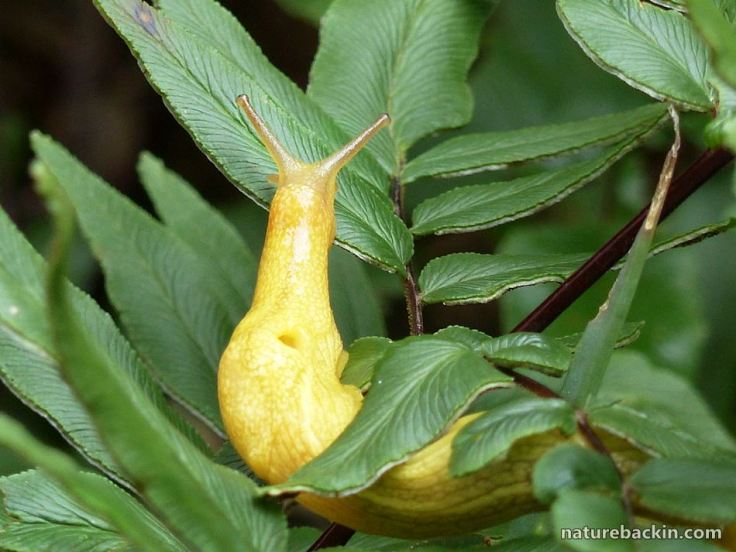
The round respiratory pore is visible just to the right of the central line on this slug
Slugs, like snails, are hermaphrodites. Each slug has male and female reproductive organs. They mate to swop sperm. Each slug has two pairs of retractable tentacles: the optic tentacles with an eye at each tip, which are also used to smell with, and a pair of feeler tentacles, which are also used for tasting.

Both optical tentacles and one of the shorter feeler tentacle can be seen in this photo. Amazingly, if a tentacle is lost through injury, another one can be grown to replace it
I was interested to learn that terrestrial slugs evolved from terrestrial snails. Some slugs have very reduced shells (for some species the remnant shell is concealed under the mantle) and some have no shell at all. Even terrestrial snails have far thinner shells than marine snails and it is perhaps the low levels of calcium on the land that led to the shell-less adaptation. To prevent slugs from drying out they have thicker skins and produce more mucus. An advantage of being without a shell is that slugs can fit into smaller spaces when foraging or hiding.
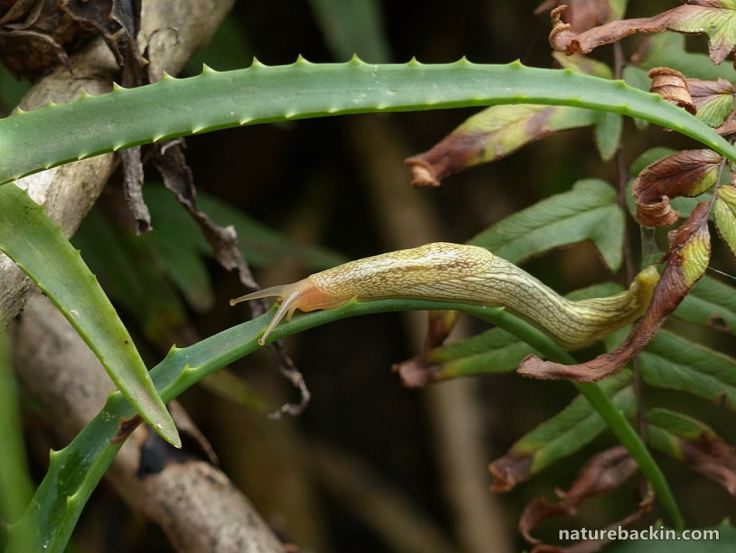
This slug decided to leave the fern via the narrow end of an aloe leaf
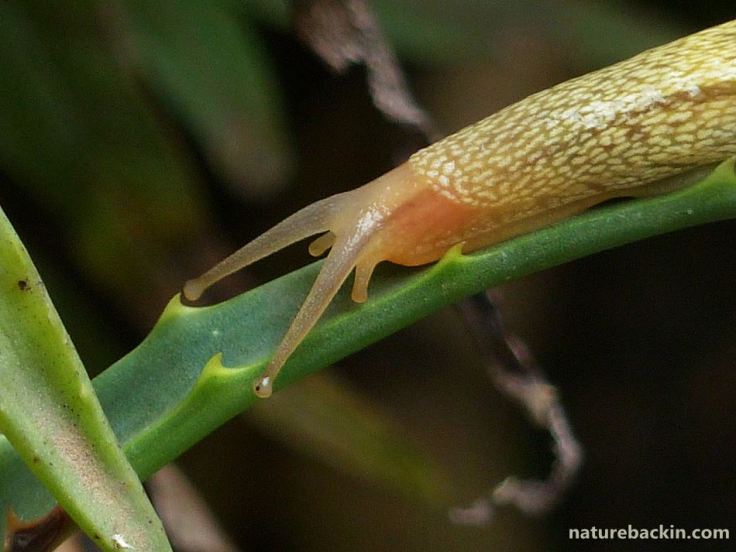
With tentacles down, it appeared to be full steam ahead
Slugs move on one large muscular foot that runs the length of the body. Some species have a skirt or frill along the edge of the foot, but this frill is absent in African banana slugs. Mucus helps lubricate their journey and also leaves a trail that they can use for later navigation. Many species leave a silvery trail, but the African banana slugs that I have watched leave no easily observable trail.
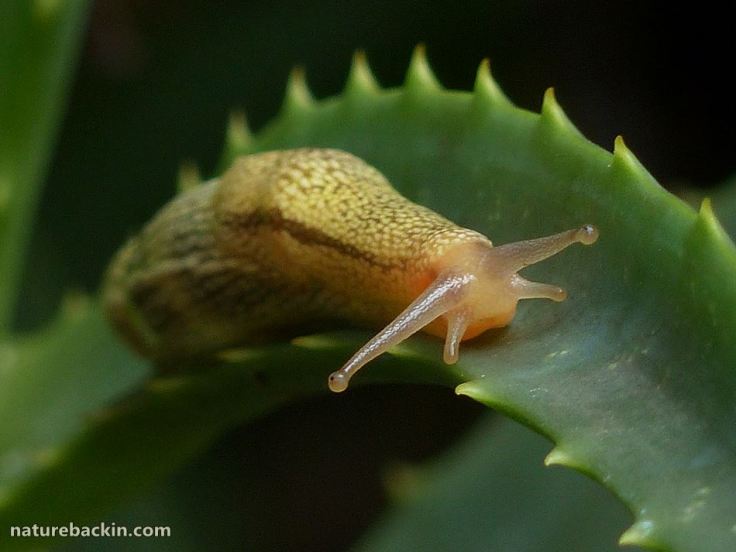
An aloe-leaf version of a perfectly contoured super freeway for slugs
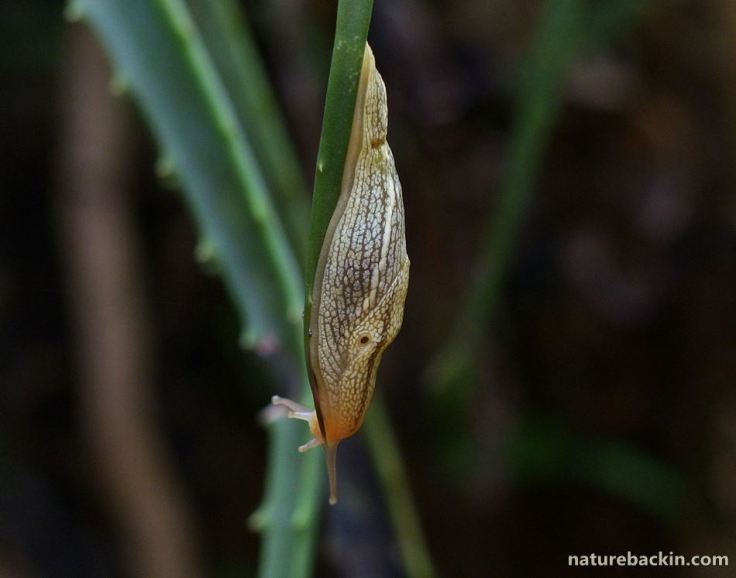
But this freeway came to a sharp and abrupt end!
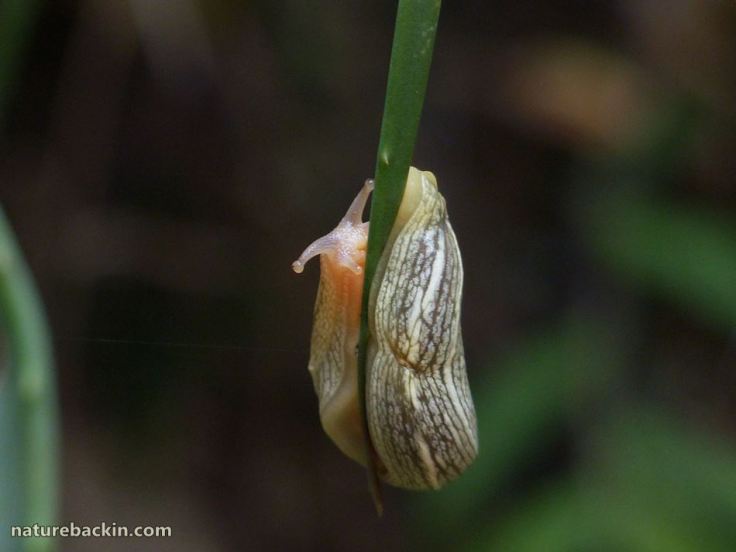
An awkward few moments – making a U-turn in slo-mo

On its way again, although on a return journey. Perhaps there are some philosophical lessons to be learned from observing slugs?

This slug is resting on the stem of a pawpaw tree in our veggie patch. Its head is retracted into the mantle
Slugs are important prey items on the menu for hedgehogs, birds, toads and other creatures. For those who find some species of slugs troublesome, creatures that predate on slugs can help keep them in check. Ruthlessly eradicating creatures such as slugs in our gardens and suburban areas has a knock-effect on other creatures too by depriving them of an important food source, even before factoring in the indiscriminate harm caused by poisons, including snail bait. Although based in the United Kingdom and focussed on hedgehogs, this post on Hedgehog friendly gardening from the Little Silver Hedgehog blog provides relevant tips for wildlife-friendly gardeners everywhere.
Best wishes for 2018 whether you have to hit the ground running or can take a more sluggish approach.
Sources:
Enchanted Learning. 2001-2016. Slugs. http://www.enchantedlearning.com/subjects/invertebrates/mollusk/gastropod/Slugprintout.shtml
Jones, Richard. 2017. Misunderstood molluscs: five reasons to love slugs. Wildlife Shortcuts. The Guardian, 4 July. https://www.theguardian.com/environment/shortcuts/2017/jul/04/misunderstood-molluscs-five-reasons-love-slug-chris-packham
Little Silver Hedgehog. 2016. Hedgehog friendly gardening. https://littlesilverhedgehog.wordpress.com/2016/01/18/hedgehog-friendly-gardening/
Londt, Jason. 2009. Suburban Wildlife in KZN. A Wildlife Handbook, WESSA KZN.
Slug Watch. 2018. All About Slugs. http://www.slugwatch.co.uk/?page_id=13
Posted by Carol









January 7, 2018 at 2:03 pm
Yup, sluggish is the word. Reading through your blog is a jolly pleasant way to spend an afternoon. Such fabulous images and interesting info.
LikeLiked by 1 person
January 10, 2018 at 3:23 am
Thanks very much Nikki and best wishes for 2018.
LikeLike
January 6, 2018 at 3:29 am
Great photos and this happily reminded me of a Gary Larson cartoon where a beaming couple in the U.S. northwest marks spring by calling, “Kids, kids, the slugs are back.”
LikeLiked by 1 person
January 6, 2018 at 7:27 pm
🙂 Gary Larson – in a league of his own.
LikeLike
January 5, 2018 at 6:29 pm
Those are wonderful shots, Carol! What a beautifully coloured and patterned slug!
LikeLiked by 1 person
January 5, 2018 at 7:15 pm
Thanks Pete. Generally, slugs are somewhat underappreciated!
LikeLiked by 1 person
January 5, 2018 at 4:55 am
What a fascinating read! It reminds me that I have not seen Banana Slugs for years, although we often encounter small snails in our garden. I look forward to reading more of your interesting accounts this year.
LikeLiked by 1 person
January 5, 2018 at 6:28 am
Conversely, we seldom see the small garden snails here anymore. I often wonder why. Thanks Anne and best wishes for the year ahead.
LikeLike
January 5, 2018 at 2:57 am
Cool. I think slugs are pretty.
LikeLiked by 1 person
January 5, 2018 at 6:09 am
Thanks Sherry. I agree and remarkably interesting too.
LikeLike
January 5, 2018 at 12:32 am
Bleah, one of my least favorite creatures, lol!
LikeLike
January 5, 2018 at 6:03 am
Fascinating though and has its role to play ☺
LikeLiked by 1 person